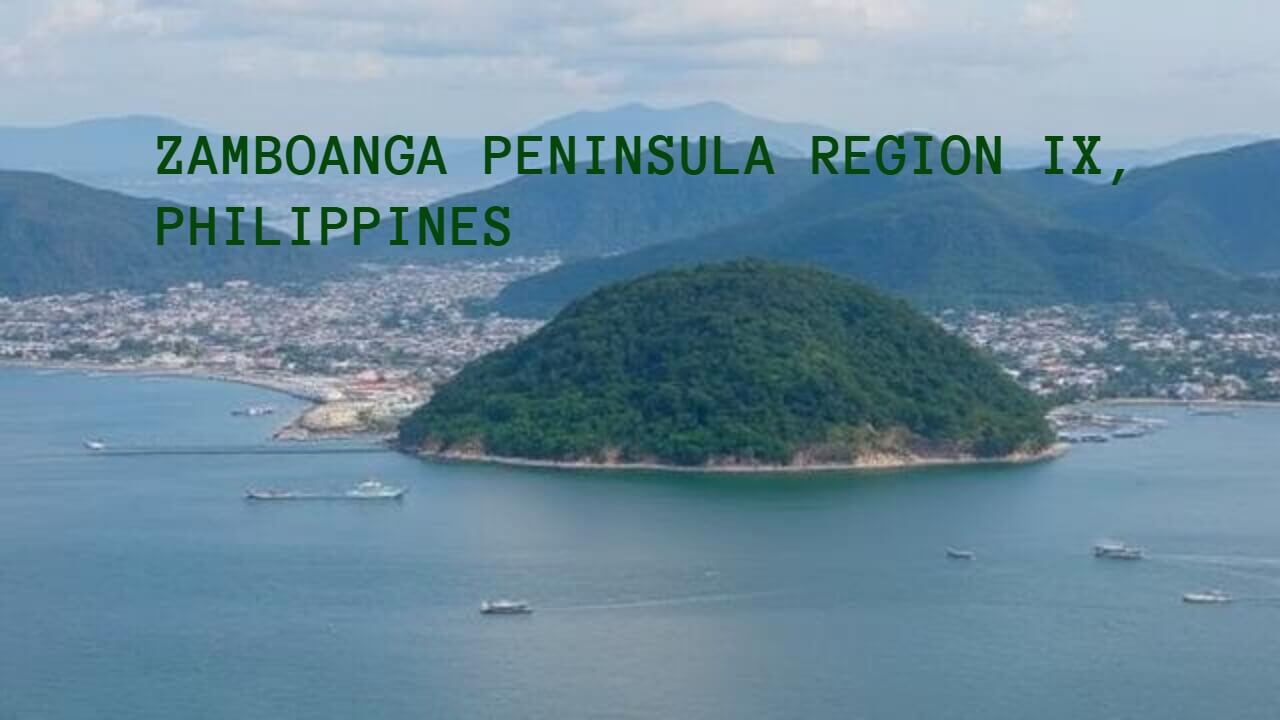Chavacano: Zamboanga Peninsula Region IX, Cebuano: Lawis as Zamboanga is a managerial section of the Philippines selected as District IX. The range includes 3 provinces (Zamboanga Sibugay, Zamboanga del Norte, and Zamboanga del Sur). Two cities (Ciudad de Isabela and Ciudad de Zamboanga, the first being a member of the Basilan province.
The second is a developed city. The district was known as West Mindanao before issuing Executive Order No. 36 on September 19, 2001. Zamboanga City was designated as a provincial center till Pagadian City was named as its current local center. Although Zamboanga City continues to be a cultural, commercial, and educational center.
Zamboanga Peninsula Region IX
Geography
The city peninsula with the same name as Zamboanga on the island of Mindanao. Between Moro Bay (part of the Celebes Sea) and the Sulu Sea. Many bays and islands of different sizes are along the shores of the peninsula. The peninsula is connected to the rest of Mindanao by the isthmus between Panguil Bay and Pagadian Bay. Their territory comprises three provinces in Zamboanga and the urbanized independent city of Zamboanga. The border between the peninsula and the mainland is marked by the border. Between the southern part of Zamboanga and the northern part of the island.
Zamboanga Peninsula Region IX – HISTORY
The Oldest Civilization
In ancient times, the Zamboanga Peninsula remained a huge field with several ethnic organizations, the biggest of which was Asian. Later, the coastal areas of the southern part of the region were affected by the Java Majapahit Empire. Although the Empire never conquered the territory.
Zamboanga Peninsula Region IX – Maguindanao Sultanate
In the fourteenth century, the Sultanate of Sulu ruled the southwestern part of the peninsula. In the late fifteenth and early sixteenth centuries, Malaysian missionaries spread Islam in the southern Philippines. Kabungsuwan Sharif, born to Malay and Arab missionaries in Johor, established the Sultanate of Maguindanao Province. Which gave its name throughout Mindanao. The Sultanate occupies the entire island. Besides the regions of Caraga and Davao. The Davao on the Zamboanga Peninsula extends the current region of the eastern region. While the Sultan of Sulu lost his territory in Zamboanga.
READ: The Mindanao Philippines
The Sultan of Maguindanao provided fierce armed resistance against Spanish occupation of Mindanao, under the leadership of Muhammad Kudarat. Soon, they formed to unite the Sultan of Sulu. Muslim Aboriginal people in the neighborhood were referred to as the Spanish Moros, meaning “Moorish”. Although Iberian Moore and Filipino Muslims aren’t under other small cultural connections in Islam. Spain – Most of the Moorish conflict, the war between the Spanish conquistadors. The indigenous Muslims in Mindanao lived on the Zamboanga Peninsula.
Zamboanga Peninsula Region IX – Spanish Rule
In 1569, Zamboanga was chosen as the garrison of the Spanish settlement and La Caldera (now known as Barrio Recodo). Zamboanga is one of the main bastions of Mindanao. They support colonial activities in the southern part of the island and pave the way for Christian settlements. A military boundary that protects islands from foreign intruders and Moro bandits and their Chinese associates.
The Zamboanga Peninsula played a central role in the Spanish-Moorish conflict. This is the place where Spanish soldiers and the pirate invasion of Moro continue to struggle. Although Spanish settlers built churches in the territory. They suffered from the Moorish attackers and had to evacuate from the place many times. Although the Spaniards achieved tactical victories, they attacked the Sultanate of Sulu. But the fighting and continued attacks still existed, which gave the Moors a psychological victory.
Zamboanga Province
After the United States took over the Spanish East Indies in 1898. The peninsula established a short-lived independent state called the Republic of Zamboanga. The island government of Moro, which comprises the Midwest of the island of Mindanao and the Sulu Islands, established it. On August 16, 1916, the name and state of Moro changed to Mindanao and Sulu, making Zamboanga an independent province.
In 1942, the Japanese Empire occupied the Zamboanga Peninsula, along with other Philippine islands in the early days of the Second World War. They liberated the peninsula in 1945 by a joint force of the United States and the Philippine Federation. Which engaged in against the Japanese Imperial Army.
On June 6, 1952, it divided the province into northern Zamboanga and southern Zamboanga. They allowed Zamboanga City to become an independent provincial unit.
Zamboanga Peninsula Region IX
Together with the Sulu Islands, the provinces that formed Zamboanga Province were reorganized in the ninth district. In the order of Presidential Decree No. 1, as part of the comprehensive restructuring plan for President Ferdinand Marcos, signed on September 24, 1972.
From 1975 to 1989, the original ninth district (West Mindanao) was divided into two divisions. According to Presidential Decree No. 8233 of August 21, 1975. Sub-region IX-A comprises Brazil, Sulu and Tawi-Tawi, and Jolo. Sulu is the sub-regional centre. The IX-B division comprises the provinces of Zamboanga del Norte, Zamboanga del Sur, and Zamboanga Sibugay. It allowed Zamboanga City as the sub-regional centre.
Zamboanga Peninsula Region IX – Today
In 2001, the province of Zamboanga del Sur. Where Ipil is the seat of the government and has the law No. 8973 of the Republic, found in Zamboanga Sibugay the same year, residents of Brasilia joined the referendum of the Muslim Autonomous Region of Mindanao (ARMM). Citizens of the capital, Isabella, do not want to join. So Executive Order 36 will make the city a part of the region.
In 2004, Pagadian became the regional center of the ninth district of Zamboanga Peninsula. Despite opposing the former regional center, Zamboanga City.
Zamboanga Peninsula Region IX – Regional Centre Problem
President Corazon Aquino issued the Executive Order (EO) in 1990, and he was responsible for restructuring the administrative region of Mindanao. He claims that West Mindanao will include Zamboanga City, Lanao del Norte. The Misamis Occidental, Zamboanga del Sur, Zamboanga del Norte, Basilan, and the cities that make up these provinces. He said that the city of Pagadian will become a new regional center.
But, President Fidel Ramos issued EO 325 in 1996 to reorganize the Regional Development Board (RDC). The EO 325 Code of Practice and Implementation Regulations (IRR) announces that Pagadian is the regional center of West Mindanao.
Zamboanga Peninsula
In 2001, President Gloria Macapagal-Arroyo signed the OE 36 and reorganized it. It was renamed to the West Mindanao to the Zamboanga Peninsula. Stay silent on regional government centers. Circular No. 75, signed by Executive Secretary Eduardo Ermita in 2004. They directed the transfer of the regional office from Zamboanga to Pagadian with EO 429 as its legal basis.
On December 22, 2010, the suspension was notified in the Memorandum No. 11. because they transferred the high economic and social costs experienced by employees in maintaining two homes to Pagadian. In addition, he directed that all entire regional offices in Pagadian continue to work.
On March 3, 2011, the Regional Development Committee IX approved Zamboanga as the regional center of the Zamboanga Peninsula.
But, despite the support of the regional center, back to Zamboanga. The Director of the National Economic and Development Agency, Arturo Valero. It is considered that if the City isn’t a local center, the capital may survive to rise. The zone should concentrate better on being an economic and technical center.
Zamboanga Peninsula Region IX – Administrative Division
The Zamboanga Peninsula comprises 3 provinces, 1 independent city, and is leased and urbanized. One rented autonomous city, 3 constituent cities, 67 municipalities, and 1,904 towns.
Isabela is a constituent city and the former capital of Brasserie. Since 2017, the Brazilian government has moved to Lamitan. It is still governed by Brasilia and used to manage provincial services and functions. For regional service management, part of the city’s Zamboanga Peninsula section. The rest of the island of Brazil is under the autonomous region of Mindanao under Muslim power.
Isabella is an outpost to the south of the Spanish in the Philippines. The earlier fall of the island of Jolo in 1878. Since 1637, Catholics have received residents and Spanish forts since 1848 (destroyed in the Second World War). The main base of the Spanish Navy. In Mindanao, until 1899, named Queen Elizabeth II. The southernmost Philippine Christian-based enclave of the city. Serves as an entry point for the trade and commerce of the island of Basilan.
Philippine Refuge
Dapitan is known as the “Philippine Refuge” because it exiled the national hero, Jose Rizal. [Need to cite] It is known as the ancient parish of St. James and the seaside resort of Dakak.
Dipolog, the capital of Zamboanga, Germany, is known for its orchids. acknowledged as the “City of Southern Orchids” or “City of Orchids” for its rich Dipolog wild orchids. They have natural places and historic places such as Dipolog Cathedral. Dipolog Avenue, Cogon Park, Japanese Park, Magsaysay Park, Sungkilaw Falls, and Linabo Peak 3000 steps.
Pagadian is known as the “Little Hong Kong in the South” because its topographical features are reminiscent of Hong Kong. It has a wealthy Chinese community that celebrates the Chinese Lunar New Year.
Zamboanga City is the only city in the region that is autonomous, authoritative, and urbanized. The city is the only member of BIMP-EAGA on the Zamboanga Peninsula. Zamboanga City accounts for more than half of the region’s economy. It has the largest airport and seaport and the city with the most investors in the region.



Leave a Reply